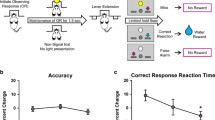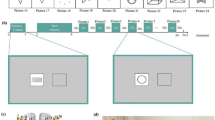Abstract
Seeking for the mechanisms by which methylphenidate (MPH) improves behavior has demonstrated that MPH modulates excitability in the primary motor cortex. However, little is known about the influence of MPH on top-down controlled mechanisms in the sensory domain. The present study explored the effects of MPH on the activation of visual cortices in healthy adults who performed a cued visuo-motor task in a double-blind placebo-controlled crossover design. Two distinct measures, posterior alpha power and occipital slow cortical potentials (SCPs), were used to reflect raise in excitability and attention-based activation of visual cortical areas. According to the results, performance parameters (reaction time, response variance and error rate) were not affected by MPH. At the neurophysiologic level reflected by reduced alpha power, MPH increased the overall excitability of the occipital cortex, but not the parietal cortex. Before the cued response, MPH reduced alpha power and increased SCPs only before right hand responses, mostly at the right occipital location. It can be concluded that in visuo-motor tasks, MPH has the potency of adjusting the background excitation/inhibition balance of visual areas. Additionally, MPH may raise the attention controlled activation of visual cortical regions, especially during increased response control.




Similar content being viewed by others
References
Andrews G, Lavine A (2006) Methylphenidate increases cortical excitability via activation of Alpha-2 noradrenergic receptors. Neuropsychopharmacol 31:594–601
Arnsten AF (2006) Stimulants: therapeutic actions in ADHD. Neuropsychopharmacol 31:2376–2383
Aron AR, Dowson JH, Sahakian BJ, Robbins TW (2003) Methylphenidate improves response inhibition in adults with attention-deficit/hyperactivity disorder. Biol Psychiatry 54:1465–1468
Bastiaansen MC, Brunia CH (2001) Anticipatory attention: an event-related desynchronization approach. Int J Psychophysiol 43:91–107
Bedard AC, Martinussen R, Ickowicz A, Tannock R (2004) Methylphenidate improves visual-spatial memory in children with attention-deficit/hyperactivity disorder. J Am Acad Child Adolesc Psychiatry 43:260–268
Brunia CH (1999) Neural aspects of anticipatory behavior. Acta Psychol (Amst) 101:213–242
Brunia CH, van Boxtel GJ (2001) Wait and see. Int J Psychophysiol 43:59–75
Brunia CH, Hackley SA, van Boxtel GJ, Kotani Y, Ohgami Y (2011) Waiting to perceive: reward or punishment? Clin Neurophysiol 122:858–868
Buchmann J, Gierow W, Weber S, Hoeppner J, Klauer T, Wittstock M, Benecke R, Haessler F, Wolters A (2006) Modulation of transcallosally mediated motor inhibition in children with attention deficit hyperactivity disorder (ADHD) by medication with methylphenidate (MPH). Neurosci Lett 405:14–18
Buchmann J, Dueck A, Gierow W, Zamorski H, Heinicke S, Heinrich H, Hoeppner J, Klauer T, Reis O, Haessler F (2010) Modulation of motorcortical excitability by methylphenidate in adult voluntary test persons performing a go/nogo task. J Neural Transm 117:249–258
Bush G, Spencer TJ, Holmes J, Shin LM, Valera EM, Seidman LJ, Makris N, Surman C, Aleardi M, Mick E, Biederman J (2008) Functional magnetic resonance imaging of methylphenidate and placebo in attention-deficit/hyperactivity disorder during the multi-source interference task. Arch Gen Psychiatry 65:102–114
Carbonnell L, Hasbroucq T, Grapperon J, Vidal F (2004) Response selection and motor areas: a behavioural and electrophysiological study. Clin Neurophysiol 115:2164–2174
Coons HW, Peloquin LJ, Klorman R, Bauer LO, Ryan RM, Perlmutter RA, Salzman LF (1981) Effect of methylphenidate on young adult’s vigilance and event-related potentials. Electroencephalogr Clin Neurophysiol 51:373–387
Damen EJ, Brunia CH (1987) Changes in heart rate and slow brain potentials related to motor preparation and stimulus anticipation in a time estimation task. Psychophysiol 24:700–713
DeVito E, Blackwell AD, Clark L, Kent L, Dezsery AM, Turner DC, Aitken MRF, Sahakian BJ (2009) Methylphenidate improves response inhibition but not reflection-impulsivity in children with attention deficit hyperactivity disorder (ADHD). Psychopharmacol (Berl) 202:531–539
Driver J, Vuilleumier P (2001) Perceptual awareness and its loss in unilateral neglect and extinction. Cognition 79:39–88
Epstein JN, Brinkman WB, Froehlich T, Langberg JM, Narad ME, Antonini TN, Shiels K, Simon JO, Altaye M (2011) Effects of stimulant medication, incentives, and event rate on reaction time variability in children with ADHD. Neuropsychopharmacol 36:1060–1072
Filipovic SR, Jahanshahi M, Rothwell JC (2000) Cortical potentials related to the nogo decision. Exp Brain Res 132:411–415
Gratton G, Coles MGH, Donchin E (1983) A new method for off-line removal of ocular artifact. Electroencephalogr Clin Neurophysiol 55:468–484
Haegens S, Osipova D, Oostenveld R, Jensen O (2010) Somatosensory working memory performance in humans depends on both engagement and disengagement of regions in a distributed network. Hum Brain Mapp 31:26–35
Haegens S, Händel BF, Jensen O (2011) Top-down controlled alpha band activity in somatosensory areas determines behavioral performance in a discrimination task. J Neurosci 31:197–204
Hoegl T, Heinrich H, Albrecht B, Diruf M, Moll GH, Kratz O (2011) Interplay of neuronal processes during response inhibition: results from a combined event-related potentials (ERPs)/transcranial magnetic stimulation (TMS) study on methylphenidate. Int J Psychophysiol 81:99–106
Hopf JM, Mangun GR (2000) Shifting visual attention in space: an electrophysiological analysis using high spatial resolution mapping. Clin Neurophysiol 111:1241–1257
Jensen O, Mazaheri A (2010) Shaping functional architecture by oscillatory alpha activity: gating by inhibition. Front Hum Neurosci 4:186
Kelly SP, Lalor EC, Reilly RB, Foxe JJ (2006) Increases in alpha oscillatory power reflect an active retinotopic mechanism for distracter suppression during sustained visuospatial attention. J Neurophysiol 95:3844–3851
Klimesch W, Sauseng P, Hanslmayr S, Gruber W, Freunberger R (2007) Event-related phase reorganization may explain evoked neural dynamics. Neurosci Biobehav Rev 31:1003–1016
Kolev V, Falkenstein M, Yordanova J (2006) Motor-response generation as a source of aging-related behavioural slowing in choice-reaction tasks. Neurobiol Aging 27:1719–1730
Kounios J, Fleck JI, Green DL, Payne L, Stevenson JL, Bowdend EM, Jung-Beeman M (2008) The origins of insight in resting-state brain activity. Neuropsychologia 46:281–291
Kratz O, Diruf M, Studer P, Gierow W, Buchmann J, Moll GH, Heinrich H (2009) Effects of methylphenidate on motor system excitability in a response inhibition task. Behav Brain Funct 27:5–12
Kratz O, Studer P, Baack J, Malcherek S, Erbe K, Moll GH, Heinrich H (2012) Pharmacological modulation of attentional functions in children with ADHD: methylphenidate vs. atomoxetine. Progr Neuro-Psychopharmacol Biol Psychiatry 37:81–89
Kuwahata T, Ishimatsu M, Kidani Y, Akasu T (2002) Effects of methylphenidate on the inhibitory postsynaptic potential in rat locus coeruleus neurons. Kurume Med J 49:49185–49190
Leuthold H (2003) Programming of expected and unexpected movements: effects on the onset of the lateralized readiness potential. Acta Psychol (Amst) 114:83–100
Linssen AM, Vuurman EF, Sambeth A, Nave S, Spooren W, Vargas G, Santarelli L, Riedel WJ (2011) Contingent negative variation as a dopaminergic biomarker: evidence from dose-related effects of methylphenidate. Psychopharmacol (Berl) 218:533–542
Lubow RE, Braunstein-Bercovitz H, Blumenthal O, Kaplan O, Toren P (2005) Latent inhibition and asymmetrical visual-spatial attention in children with ADHD. Child Neuropsychol 11:445–457
Mallat S (1999) A wavelet tour of signal processing, 2nd edn. Academic Press, San Diego
Mathewson KE, Lleras A, Beck DM, Fabiani M, Ro T, Gratton G (2011) Pulsed out of awareness: EEG alpha oscillations represent a pulsed-inhibition of ongoing cortical processing. Front Psychol 2:99
Moll GH, Heinrich H, Trott G, Wirth S, Rothenberger A (2000) Deficient intracortical inhibition in drug-naive children with attention-deficit hyperactivity disorder is enhanced by methylphenidate. Neurosci Lett 284:121–125
Moll GH, Heinrich H, Rothenberger A (2003) Methylphenidate and intracortical excitability: opposite effects in healthy subjects and attention-deficit hyperactivity disorder. Acta Psychiatr Scand 107:69–72
Oldfield RC (1971) The assessment and analysis of handedness: the Edinburgh inventory. Neuropsychologia 9:97–113
Pfurtscheller G, Lopes da Silva F (1999) Event-related EEG/MEG synchronization and desynchronization: basic principles. Clin Neurophysiol 110:1842–1857
Pietrzak RH, Mollica CM, Maruff P, Snyder PJ (2006) Cognitive effects of immediate-release methylphenidate in children with attention-deficit/hyperactivity disorder. Neurosci Biobehav Rev 30:1225–1245
Rapport MD, Kelly KL (1993) Psychostimulant effects on learning and cognitive function. In: Matson JL (ed) Handbook of hyperactivity in children. Allyn & Bacon, Boston, pp 97–136
Rektor I, Sochurková D, Bocková M (2006) Intracerebral ERD/ERS in voluntary movement and in cognitive visuomotor task. Progr Brain Res 159:311–330
Richter MM, Ehlis AC, Jacob CP, Fallgatter AJ (2007) Cortical excitability in adult patients with attention-deficit/hyperactivity disorder (ADHD). Neurosci Lett 419:137–141
Rihs TA, Michel CM, Thut G (2007) Mechanisms of selective inhibition in visual spatial attention are indexed by alpha-band EEG synchronization. Eur J Neurosci 25:603–610
Rockstroh B (1989) Slow cortical potentials and behaviour, 2nd edn. Urban & Schwarzenberg, New York
Rockstroh B, Elbert T, Lutzenberger W, Birbaumer N (1982) The effects of slow cortical potentials on response speed. Psychophysiol 19:211–217
Romei V, Brodbeck V, Michel C, Amedi A, Pascual-Leone A, Thut G (2008) Spontaneous fluctuations in posterior alpha-band EEG activity reflect variability in excitability of human visual areas. Cereb Cortex 18:2010–2018
Rubia K, Halari R, Cubillo A, Smith AB, Mohammad AM, Brammer M, Taylor E (2011a) Methylphenidate normalizes fronto-striatal underactivation during interference inhibition in medication-naïve boys with attention-deficit hyperactivity disorder. Neuropsychopharmacol 36:1575–1586
Rubia K, Halari R, Mohammad AM, Taylor E, Brammer M (2011b) Methylphenidate normalizes frontocingulate underactivation during error processing in attention-deficit/hyperactivity disorder. Biol Psychiatry 70:255–262
Rushworth MF, Nixon PD, Renowden S, Wade DT, Passingham RE (1997) The left parietal cortex and motor attention. Neuropsychologia 35:1261–1273
Rushworth MF, Ellison A, Walsh V (2001) Complementary localization and lateralization of orienting and motor attention. Nat Neurosci 4:656–661
Samar VJ (1999) Wavelet analysis of neuroelectric waveforms. Brain Lang 66:1–6
Sauseng P, Klimesch W, Stadler W, Schabus M, Doppelmayr M, Hanslmayr S, Gruber WR, Birbaumer N (2005) A shift of visual spatial attention is selectively associated with human EEG alpha activity. Eur J Neurosci 22:2917–2926
Scheibe C, Schubert R, Sommer W, Heekeren HR (2009) Electrophysiological evidence for the effect of prior probability on response preparation. Psychophysiol 46:758–770
Schneider M, Retz W, Freitag C, Irsch J, Graf P, Retz-Junginger P, Rösler M (2007) Impaired cortical inhibition in adult ADHD patients: a study with transcranial magnetic stimulation. J Neural Transm 72:303–309
Spencer SV, Hawk LW Jr, Richards JB, Shiels K, Pelham WE Jr, Waxmonsky JG (2009) Stimulant treatment reduces lapses in attention among children with ADHD: the effects of methylphenidate on intra-individual response time distributions. J Abnorm Child Psychol 37:805–816
Swinnen SP, Li Y, Dounskaia N, Byblow W, Stinear C, Wagemans J (2004) Perception–action coupling during bimanual coordination: the role of visual perception in the coalition of constraints that govern bimanual action. J Mot Behav 36:394–398, 402–407 (discussion 408–417)
Sylvester CM, Shulman GL, Jack AI, Corbetta M (2007) Asymmetry of anticipatory activity in visual cortex predicts the locus of attention and perception. J Neurosci 27:14424–14433
Tallon-Baudry C, Bertrand O (1999) Oscillatory gamma activity in humans and its role in object representation. Trends Cogn Sci 3:151–162
Tallon-Baudry C, Bertrand O, Delpuech C, Pernier J (1996) Stimulus specificity of phase-locked and non-phase-locked 40 Hz visual responses in human. J Neurosci 16:4240–4249
The MTA Cooperative Group (1999) A 14-month randomized clinical trial of treatment strategies for attention deficit/hyperactivity disorder. Arch Gen Psychiatry 56:1073–1086
Thut G, Nietzel A, Brandt SA, Pascual-Leone A (2006) Alpha-band electroencephalographic activity over occipital cortex indexes visuospatial attention bias and predicts visual target detection. J Neurosci 26:94494–94502
Tomasi D, Volkow ND, Wang GJ, Wang R, Telang F, Caparelli EC, Wong C, Jayne M, Fowler JS (2011) Methylphenidate enhances brain activation and deactivation responses to visual attention and working memory tasks in healthy controls. NeuroImage 54:3101–3110
Wild-Wall N, Sangals J, Sommer W, Leuthold H (2003) Are fingers special? Evidence about movement preparation from event-related brain potentials. Psychophysiol 40:7–16
Worden MS, Foxe JJ, Wang N, Simpson GV (2000) Anticipatory biasing of visuospatial attention indexed by retinotopically specific α-band electroencephalography increases over occipital cortex. J Neurosci 20:1–6
Yordanova J, Falkenstein M, Hohnsbein J, Kolev V (2004) Parallel systems of error processing in the brain. NeuroImage 22:590–602
Acknowledgments
The study was supported by EU COST action B27 ENOC (Electric Neuronal Oscillations and Cognition). The authors are thankful to Martin Deinzer for technical assistance and data recording.
Author information
Authors and Affiliations
Corresponding author
Rights and permissions
About this article
Cite this article
Hodzhev, Y., Yordanova, J., Diruf, M. et al. Methylphenidate (MPH) promotes visual cortical activation in healthy adults in a cued visuomotor task. J Neural Transm 119, 1455–1464 (2012). https://doi.org/10.1007/s00702-012-0799-6
Received:
Accepted:
Published:
Issue Date:
DOI: https://doi.org/10.1007/s00702-012-0799-6




